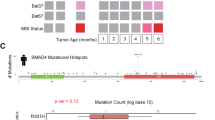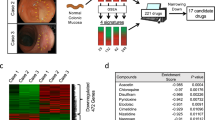Abstract
We have recently identified a positive feedback loop in which c-MYC increases silent information regulator 1 (SIRT1) protein level and activity through transcriptional activation of nicotinamide phosphoribosyltransferase (NAMPT) and NAD+ increase. Here, we determined the relevance of the c-MYC–NAMPT–SIRT1 feedback loop, including the SIRT1 inhibitor deleted in breast cancer 1 (DBC1), for the development of conventional and serrated colorectal adenomas. Immunohistochemical analyses of 104 conventional adenomas with low- and high-grade dysplasia and of 157 serrated lesions revealed that elevated expression of c-MYC, NAMPT, and SIRT1 characterized all conventional and serrated adenomas, whereas DBC1 was not differentially regulated. Analyzing publicly available pharmacogenomic databases from 43 colorectal cancer cell lines demonstrated that responsiveness towards a NAMPT inhibitor was significantly associated with alterations in PTEN and TGFBR2, while features such as BRAF or RNF43 alterations, or microsatellite instability typical for serrated route colorectal cancer, showed increased sensitivities for inhibition of NAMPT and SIRT1. Our findings suggest an activation of the c-MYC–NAMPT–SIRT1 feedback loop that may crucially contribute to initiation and development of both routes to colorectal cancer. Targeting of NAMPT or SIRT1 may represent novel therapeutic strategies with putative higher sensitivity of the serrated route colorectal cancer subtype.






Similar content being viewed by others
References
Vogelstein B, Fearon ER, Hamilton SR, Kern SE, Preisinger AC, Leppert M, et al. Genetic alterations during colorectal-tumor development. N Engl J Med. 1988;319(9):525–32. https://doi.org/10.1056/NEJM198809013190901.
Dang CV. MYC on the path to cancer. Cell. 2012;149(1):22–35. https://doi.org/10.1016/j.cell.2012.03.003.
Menssen A, Hermeking H. c-MYC and SIRT1 locked in a vicious cycle. Oncotarget. 2012;3(2):112–3. https://doi.org/10.18632/oncotarget.440.
Menssen A, Hydbring P, Kapelle K, Vervoorts J, Diebold J, Luscher B, et al. The c-MYC oncoprotein, the NAMPT enzyme, the SIRT1-inhibitor DBC1, and the SIRT1 deacetylase form a positive feedback loop. Proc Natl Acad Sci USA. 2012;109(4):E187-96. https://doi.org/10.1073/pnas.1105304109.
Nosho K, Shima K, Irahara N, Kure S, Firestein R, Baba Y, et al. SIRT1 histone deacetylase expression is associated with microsatellite instability and CpG island methylator phenotype in colorectal cancer. Mod Pathol. 2009;22(7):922–32. https://doi.org/10.1038/modpathol.2009.49.
Leko V, Park GJ, Lao U, Simon JA, Bedalov A. Enterocyte-specific inactivation of SIRT1 reduces tumor load in the APC(+/min) mouse model. PLoS ONE. 2013;8(6):e66283. https://doi.org/10.1371/journal.pone.0066283.
Kriegl L, Vieth M, Kirchner T, Menssen A. Up-regulation of c-MYC and SIRT1 expression correlates with malignant transformation in the serrated route to colorectal cancer. Oncotarget. 2012;3(10):1182–93. https://doi.org/10.18632/oncotarget.628.
Noffsinger AE. Serrated polyps and colorectal cancer: new pathway to malignancy. Annu Rev Pathol. 2009;4:343–64. https://doi.org/10.1146/annurev.pathol.4.110807.092317.
Chalkiadaki A, Guarente L. The multifaceted functions of sirtuins in cancer. Nat Rev Cancer. 2015;15(10):608–24. https://doi.org/10.1038/nrc3985.
Sampath D, Zabka TS, Misner DL, O’Brien T, Dragovich PS. Inhibition of nicotinamide phosphoribosyltransferase (NAMPT) as a therapeutic strategy in cancer. Pharmacol Ther. 2015;151:16–31. https://doi.org/10.1016/j.pharmthera.2015.02.004.
Barretina J, Caponigro G, Stransky N, Venkatesan K, Margolin AA, Kim S, et al. The Cancer Cell Line Encyclopedia enables predictive modelling of anticancer drug sensitivity. Nature. 2012;483(7391):603–7. https://doi.org/10.1038/nature11003.
Iorio F, Knijnenburg TA, Vis DJ, Bignell GR, Menden MP, Schubert M, et al. A landscape of pharmacogenomic interactions in cancer. Cell. 2016;166(3):740–54. https://doi.org/10.1016/j.cell.2016.06.017.
Yang W, Soares J, Greninger P, Edelman EJ, Lightfoot H, Forbes S, et al. Genomics of Drug Sensitivity in Cancer (GDSC): a resource for therapeutic biomarker discovery in cancer cells. Nucleic Acids Res. 2013;41(Database issue):D955-61. https://doi.org/10.1093/nar/gks1111.
Hamilton SRBF, Boffetta P, Ilyas M, Nakamura SI, Quirke P, Riboli E, Sobin LH. Carcinoma of the colon and rectum. In: Bosman FT CF, Hruban RH, Theise ND, editor. WHO Classification of Tumors of the Digestive System. Lyon (France): International Agency for Research on cancer (IARC); 2010. p. 139.
Torlakovic EE, Gomez JD, Driman DK, Parfitt JR, Wang C, Benerjee T, et al. Sessile serrated adenoma (SSA) vs. traditional serrated adenoma (TSA). Am J Surg Pathol. 2008;32(1):21–9. https://doi.org/10.1097/PAS.0b013e318157f002.
Cancer Genome Atlas N. Comprehensive molecular characterization of human colon and rectal cancer. Nature. 2012;487(7407):330–7. https://doi.org/10.1038/nature11252.
Bond CE, McKeone DM, Kalimutho M, Bettington ML, Pearson SA, Dumenil TD, et al. RNF43 and ZNRF3 are commonly altered in serrated pathway colorectal tumorigenesis. Oncotarget. 2016;7(43):70589–600. https://doi.org/10.18632/oncotarget.12130.
Slattery ML, Herrick JS, Mullany LE, Samowitz WS, Sevens JR, Sakoda L, et al. The co-regulatory networks of tumor suppressor genes, oncogenes, and miRNAs in colorectal cancer. Genes Chromosomes Cancer. 2017;56(11):769–87. https://doi.org/10.1002/gcc.22481.
Ueda M, Iguchi T, Masuda T, Komatsu H, Nambara S, Sakimura S, et al. Up-regulation of SLC9A9 promotes cancer progression and is involved in poor prognosis in colorectal cancer. Anticancer Res. 2017;37(5):2255–63. https://doi.org/10.21873/anticanres.11562.
Berg KCG, Eide PW, Eilertsen IA, Johannessen B, Bruun J, Danielsen SA, et al. Multi-omics of 34 colorectal cancer cell lines - a resource for biomedical studies. Mol Cancer. 2017;16(1):116. https://doi.org/10.1186/s12943-017-0691-y.
Mouradov D, Sloggett C, Jorissen RN, Love CG, Li S, Burgess AW, et al. Colorectal cancer cell lines are representative models of the main molecular subtypes of primary cancer. Cancer Res. 2014;74(12):3238–47. https://doi.org/10.1158/0008-5472.CAN-14-0013.
Yadamsuren EA, Nagy S, Pajor L, Lacza A, Bogner B. Characteristics of advanced- and non advanced sporadic polypoid colorectal adenomas: correlation to KRAS mutations. Pathol Oncol Res. 2012;18(4):1077–84. https://doi.org/10.1007/s12253-012-9547-3.
Kim JE, Chen J, Lou Z. DBC1 is a negative regulator of SIRT1. Nature. 2008;451(7178):583–6. https://doi.org/10.1038/nature06500.
Milner J. Cellular regulation of SIRT1. Curr Pharm Des. 2009;15(1):39–44.
He TC, Sparks AB, Rago C, Hermeking H, Zawel L, da Costa LT, et al. Identification of c-MYC as a target of the APC pathway. Science. 1998;281(5382):1509–12.
Gabay M, Li Y, Felsher DW. MYC activation is a hallmark of cancer initiation and maintenance. Cold Spring Harbor Perspect Med. 2014;4(6). https://doi.org/10.1101/cshperspect.a014241.
Feng Y, Bommer GT, Zhao J, Green M, Sands E, Zhai Y, et al. Mutant KRAS promotes hyperplasia and alters differentiation in the colon epithelium but does not expand the presumptive stem cell pool. Gastroenterology. 2011;141(3):1003–13 e1–10. https://doi.org/10.1053/j.gastro.2011.05.007.
Le Rolle AF, Chiu TK, Zeng Z, Shia J, Weiser MR, Paty PB, et al. Oncogenic KRAS activates an embryonic stem cell-like program in human colon cancer initiation. Oncotarget. 2016;7(3):2159–74. https://doi.org/10.18632/oncotarget.6818.
Giaretti W, Rapallo A, Geido E, Sciutto A, Merlo F, Risio M, et al. Specific K-ras2 mutations in human sporadic colorectal adenomas are associated with DNA near-diploid aneuploidy and inhibition of proliferation. Am J Pathol. 1998;153(4):1201–9. https://doi.org/10.1016/S0002-9440(10)65664-7.
Chen X, Sun K, Jiao S, Cai N, Zhao X, Zou H, et al. High levels of SIRT1 expression enhance tumorigenesis and associate with a poor prognosis of colorectal carcinoma patients. Sci Rep. 2014;4:7481. https://doi.org/10.1038/srep07481.
Cheng F, Su L, Yao C, Liu L, Shen J, Liu C, et al. SIRT1 promotes epithelial-mesenchymal transition and metastasis in colorectal cancer by regulating Fra-1 expression. Cancer Lett. 2016;375(2):274–83. https://doi.org/10.1016/j.canlet.2016.03.010.
Finch AJ, Soucek L, Junttila MR, Swigart LB, Evan GI. Acute overexpression of Myc in intestinal epithelium recapitulates some but not all the changes elicited by Wnt/beta-catenin pathway activation. Mol Cell Biol. 2009;29(19):5306–15. https://doi.org/10.1128/MCB.01745-08.
Kitani T, Okuno S, Fujisawa H. Growth phase-dependent changes in the subcellular localization of pre-B-cell colony-enhancing factor. FEBS Lett. 2003;544(1–3):74–8.
Imai S, Guarente L. NAD+ and sirtuins in aging and disease. Trends Cell Biol. 2014;24(8):464–71. https://doi.org/10.1016/j.tcb.2014.04.002.
Taylor CT, Colgan SP. Hypoxia and gastrointestinal disease. J Mol Med (Berl). 2007;85(12):1295–300. https://doi.org/10.1007/s00109-007-0277-z.
Bae SK, Kim SR, Kim JG, Kim JY, Koo TH, Jang HO, et al. Hypoxic induction of human visfatin gene is directly mediated by hypoxia-inducible factor-1. FEBS Lett. 2006;580(17):4105–13. https://doi.org/10.1016/j.febslet.2006.06.052.
Zhang LQ, Van Haandel L, Xiong M, Huang P, Heruth DP, Bi C, et al. Metabolic and molecular insights into an essential role of nicotinamide phosphoribosyltransferase. Cell Death Dis. 2017;8:e2705. https://doi.org/10.1038/cddis.2017.132.
Kim JE, Lou Z, Chen J. Interactions between DBC1 and SIRT 1 are deregulated in breast cancer cells. Cell Cycle. 2009;8(22):3784–5. https://doi.org/10.4161/cc.8.22.10055.
Li L, Wang L, Li L, Wang Z, Ho Y, McDonald T, et al. Activation of p53 by SIRT1 inhibition enhances elimination of CML leukemia stem cells in combination with imatinib. Cancer Cell. 2012;21(2):266–81. https://doi.org/10.1016/j.ccr.2011.12.020.
Wang Z, Yuan H, Roth M, Stark JM, Bhatia R, Chen WY. SIRT1 deacetylase promotes acquisition of genetic mutations for drug resistance in CML cells. Oncogene. 2013;32(5):589–98. https://doi.org/10.1038/onc.2012.83.
Markowitz S, Wang J, Myeroff L, Parsons R, Sun L, Lutterbaugh J, et al. Inactivation of the type II TGF-beta receptor in colon cancer cells with microsatellite instability. Science. 1995;268(5215):1336–8.
Massague J. TGF-beta signal transduction. Annu Rev Biochem. 1998;67:753–91. https://doi.org/10.1146/annurev.biochem.67.1.753.
Hann SR. Role of post-translational modifications in regulating c-Myc proteolysis, transcriptional activity and biological function. Semin Cancer Biol. 2006;16(4):288–302. https://doi.org/10.1016/j.semcancer.2006.08.004.
Zehir A, Benayed R, Shah RH, Syed A, Middha S, Kim HR, et al. Mutational landscape of metastatic cancer revealed from prospective clinical sequencing of 10,000 patients. Nat Med. 2017;23(6):703–13. https://doi.org/10.1038/nm.4333.
Peck B, Chen CY, Ho KK, Di Fruscia P, Myatt SS, Coombes RC, et al. SIRT inhibitors induce cell death and p53 acetylation through targeting both SIRT1 and SIRT2. Mol Cancer Ther. 2010;9(4):844–55. https://doi.org/10.1158/1535-7163.MCT-09-0971.
Acknowledgements
This study was supported by the German Research Foundation (Deutsche Forschungsgemeinschaft) Grant (# Me1719/3-1) (support to AM). We thank A. Heier for her expert support and experimental assistance.
Author information
Authors and Affiliations
Corresponding author
Ethics declarations
Conflict of interest
The authors declare that they have no conflict of interest.
Research involving human participants
Data and specimens were anonymized, and the need for consent was waived by the institutional ethics committee of the Medical Faculty of the Ludwig-Maximilians University.
Electronic supplementary material
Below is the link to the electronic supplementary material.
Rights and permissions
About this article
Cite this article
Brandl, L., Kirstein, N., Neumann, J. et al. The c-MYC/NAMPT/SIRT1 feedback loop is activated in early classical and serrated route colorectal cancer and represents a therapeutic target. Med Oncol 36, 5 (2019). https://doi.org/10.1007/s12032-018-1225-1
Received:
Accepted:
Published:
DOI: https://doi.org/10.1007/s12032-018-1225-1




